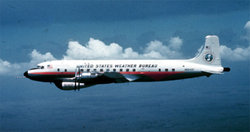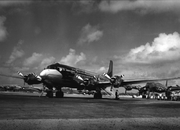Douglas DC-6
|
|
| Douglas DC-6B | ||
|---|---|---|

| ||
| Description | ||
| Role | Civil air transport | |
| Crew | 3 or 4 | |
| First Flight | 1946 | |
| Manufacturer | Douglas Aircraft Company, Long Beach, California | |
| Dimensions | ||
| Length | 105 ft 7 in | 32.2 m |
| Wingspan | 105 ft 7 in | 32.2 m |
| Height | 28 ft 9 in | 8.8 m |
| Wing area | 1,463 ft² | 135.9 m² |
| Weights | ||
| Empty | 55,360 lb | 25,110 kg |
| Maximum takeoff | 107,000 lb | 48,500 kg |
| Capacity | 88 to 102 passengers | |
| Powerplant | ||
| Engines | Four Pratt & Whitney R-2800 Double Wasp radial piston engines | |
| Power | 10,000 hp | 7,460 kW |
| Performance | ||
| Cruising speed | 315 mph | 507 km/h |
| Maximum speed | 400 mph | 644 km/h |
| Operating range | 3,000 miles | 5,000 km |
| Service ceiling | 25,000 ft | 7,600 m |
| Rate of climb | 1,070 ft/min | 326 m/min |
| Wing loading | 73 lb/ft² | 356 kg/m² |
| Power/Mass | 0.09 hp/lb | 150 W/kg |
The Douglas DC-6 is an aircraft built by the Douglas Aircraft Company from 1946 to 1959. Originally intended as a military transport near the end of World War II, it was reworked after the war to compete with the Lockheed Constellation in the long-range piston transport market. More than 700 were built, and many still fly today in cargo, military, and wildfire control roles.
The DC-6 was known as the C-118 Liftmaster in United States Air Force service, and as the R6D in United States Navy service.
History
The United States Army Air Force commissioned the DC-6 project as the "YC112" in 1944. The Air Force wanted an expanded version of the popular C-54 transport, with improved engines. By the time the YC112 flew, the war was over, and the USAAF had rescinded its requirement.
Douglas converted its prototype into a civil air transport and delivered the first production DC-6 in March of 1947. However, a series of mysterious in-flight fires (including the fatal crash of United Airlines Flight 608) grounded the DC-6 fleet later that year: the cause was found to be a fuel vent located adjacent to the cabin heater intake. All DC-6's in service were modified to correct the problem, and the fleet was flying again after just four months on the ground.
Pan Am used DC-6 aircraft to inaugurate its first trans-Atlantic tourist class flights, starting in 1952.
Douglas designed three basic variants of the DC-6: the DC-6A was designed for cargo work, while the DC-6B was designed for passenger work and the DC-6C was a "convertible" aircraft that could accommodate both.
The military renewed its interest in the DC-6 during the Korean War, and commissioned a number of aircraft that later found their way into civilian service. Harry Truman's first presidential aircraft was an Air Force C-118 called The Independence.
Many older DC-6 aircraft were replaced by the Douglas DC-7: those that survived into the Jet Age were replaced by Boeing 707 and Douglas DC-8 aircraft.
Airlines
Historical operators of the DC-6 include Aerolíneas Argentinas, Air Vietnam, Alaska Airlines, American Airlines, Aviateca, Canadian Pacific Air Lines, KLM, Mexicana, National Airlines, Northwest Orient, Olympic Airways, Pan American World Airways, Philippine Airlines, Sabena, SAS, TEAL, United Airlines, Western Airlines, and Yemen Airlines.
Today, most DC-6's in commercial use are based in Alaska. Air Cargo Express, Everts Air Fuel, and Northern Air Cargo operate the type. Several other DC-6's are still in operation for small carriers in South America. Atlantic Airlines, a cargo carrier based in Coventry, England, also uses the type.
| Related content | |
|---|---|
| Related Development |
DC-4 - DC-7 - C-118 Liftmaster |
| Similar Aircraft | |
| Designation Series | |
| Related Lists | |
External Links
- DC-6 Images (http://www.ruudleeuw.com/dc6.htm)
- Airliners.net on the DC-6 (http://www.airliners.net/info/stats.main?id=190)
- Images of an Australian DC-6 (http://users.chariot.net.au/~theburfs/DC6MAIN.html)
- Oldprops.com Many Images (http://www.oldprops.f9.co.uk/DC6%20Photographs.htm)
|
Lists of Aircraft | Aircraft manufacturers | Aircraft engines | Aircraft engine manufacturers Airports | Airlines | Air forces | Aircraft weapons | Missiles | Timeline of aviation |

